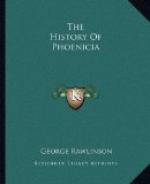relatively so vast, has represented on it a series
of scenes, remarkably alike for the style of their
execution, the diversity of their subject-matter, the
number of the persons introduced, and the nature of
the acts which they accomplish. . . . The scenes,
however, are not, as some have imagined, a series
of detached fantastic subjects, arbitrarily chosen
and capriciously grouped, a mere confused melee
of men, animals, chariots, and other objects; on the
contrary, they form a little history, a plastic idyll,
a story with a beginning, a middle, and an end.
It is a narrative divided into nine scenes.”
(1) An armed hero, mounted in a car driven by a charioteer,
quits in the morning a castle or fortified town.
He is going to hunt, and carries his bow in his left
hand. Over his head is an umbrella, the badge
of his high rank, and his defence against the mid-day
sun. A quiver hangs at the side of his chariot.
He wears a conical cap, while the driver has his head
bare, and leans forwards over the front of the car,
seeming to shake the reins, and encourage the horses
to mend their pace. (2) After the car has proceeded
a certain distance, the hunter espies a stag upon
a rocky hill. He stops his chariot, gets down,
and leaving the driver in charge of the vehicle, ensconces
himself behind a tree, and thus screened lets fly an
arrow against the quarry, which strikes it midway
in the chest. (3) Weak and bleeding copiously, the
stag attempts to escape; but the hunter pursues and
takes possession of him without having to shoot a second
time. (4) The hour is come now for a rest. The
sportsman has reached a wood, in which date-bearing
palms are intermingled with trees of a different kind.
He fastens his game to one of them, and proceeds to
the skinning and the disembowelling. Meanwhile,
his attendant detaches the horses from the car, relieves
them of their harness, and proceeds to feed them from
a portable manger. The car, left to itself, is
tilted back, and stands with its pole in the air.
(5) Food and drink having been prepared and placed
on two tables, or altars, the hunter, seated on a throne
under the shadow of his umbrella, pours a libation
to the gods. They, on their part, scent the feast
and draw near, represented by the sun and moon—a
winged disk, and a crescent embracing a full orb.
The feast is also witnessed by a spirit of evil, in
the shape of a huge baboon or cynocephalous ape, who
from a cavern at the foot of a wooded mountain, whereon
a stag and a hare are feeding, furtively surveys the
ceremony. (6) Remounting his chariot the hunter sets
out on his return home, when the baboon quits his
concealment, and rushes after him, threatening him
with a huge stone. Hereupon a winged deity descends
from heaven, and lifting into the air chariot, horses,
charioteer, and hunter, enfolds them in an embrace
and saves them. (7) The ape, baffled, pursues his
way; the chariot is replaced on the earth. The
hunter prepares his bow, places an arrow on the string,
and hastily pursues his enemy, who is speedily overtaken
and thrown to the ground by the horses. (8) The hunter
dismounts, puts his foot upon the prostrate ape, and
gives him the coup de grace with a heavy axe
or mace. A bird of prey hovers near, ready to
descend upon the carcase. (9) The hero remounts his
chariot, and returns to the castle or city which he
left in the morning.[783]




